Corsair One Review: Small, Quiet and Awesomely Powerful
The Corsair One packs 4K and VR-ready performance into a strikingly compact and quiet chassis.
Why you can trust Tom's Guide
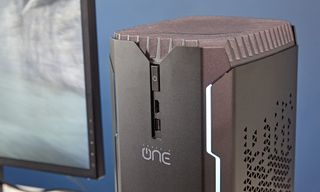
After making PC parts and accessories for decades, Corsair has finally entered the gaming-desktop arena with the Corsair One — and the company has made quite a splash doing so. This PC ($1,799 starting; $2,199 as tested) is strikingly small, cramming an Intel Core i7 processor and Nvidia GTX 1080 graphics into a living-room-ready package that's as powerful as it is quiet. The One is a fantastic PC debut from Corsair, though it has some serious competition from desktops that are smaller, more upgradable and more customizable.
Design
It's hard not to admire how wonderfully compact the Corsair One is. This small, cylindrical gaming PC finds a sweet spot between subtlety and style, with glowing baby-blue LED strips on the front and Corsair's signature sci-fi-esque etchings on the sides. Factor in the large vent at the top, and you've got a desktop that looks somewhere in between a much cooler Mac Pro and an oversize Amazon Echo.

Although you can't change the color of the One's front lights, you can adjust how bright they are, as well as toggle whether they glow statically or pulsate. Corsair said it omitted RGB lighting to maintain a more straightforward design and help keep the desktop run as quietly as possible. Personally, I’m a big fan of the desktop's blue glow, though folks who prefer adjustable lighting will probably gravitate toward the similarly small MSI Vortex and its myriad color options.
Measuring 14.96 x 7.87 x 6.9 inches, the Corsair One will barely make a dent on your desk and should blend into most living rooms without a problem — though it's too tall to slide into a shelf. It's not quite as compact as the coffeepot-size Vortex, but it's significantly smaller than midsize towers such as the Alienware Aurora.

The Corsair's 16-pound chassis is fairly light and easy to carry for a gaming PC. That portability proved invaluable when I needed the system most. One of our recent office live streams seemed doomed after our PS4 and Xbox One both acted up, but I was able to grab our One from the lab and get it up and running just as I would with a console, thanks to its small, simple design.
Ports and Upgradability
The Corsair One's front ports are as minimal as possible, with just a USB 3.1 port and an HDMI port for easily connecting to your virtual-reality headset. While I appreciate how seamless the front of the PC looks, I would have appreciated a front-facing headphone jack.
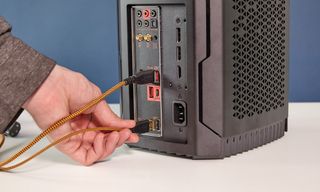
The remainder of the One's ports are laid out neatly in the back, where you'll find three USB 3.1 ports, two USB 2.0 ports and a USB Type-C port for use with newer gadgets. You'll also have access to an Ethernet jack and a full suite of audio connections.
The desktop sports two DisplayPort 1.4 connections and an HDMI 2.0 port for connecting to its Nvidia GTX 1080 graphics card, giving you plenty of options for connecting multiple monitors.
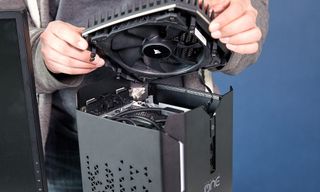
You can pop open the top of the One to clean the fan, but that's about as far as you'll get without cracking out a screwdriver. Although it's possible to take apart the One if you're willing to get your hands dirty, Corsair says the system is designed for folks who want a complete experience out of the box, rather than for DIY enthusiasts.
While this is fine for the average gamer, it's a bit of a bummer if you want the option to easily swap out graphics cards or RAM over time, as you can on the Alienware Aurora. If you end up needing to replace a part on the One, the desktop's two-year warranty would cover repairs and technical support.
Gaming and VR Performance
Sporting an Nvidia GTX 1080 graphics card, the Corsair One packs a ton of gaming muscle into its unassumingly sleek frame. Playing Mass Effect: Andromeda on the machine was a joy — I fought off aliens on a sunny outpost in beautiful 4K at 30 frames per second, and jumped and dashed around the arena at a gloriously smooth 60 fps when I turned things down to 2560 x 1440.
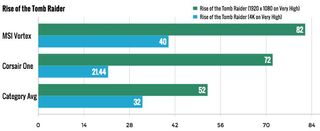
Corsair's PC had no problem churning through our Rise of the Tomb Raider test (1080p at max settings), rendering the game's rich environments at a slick 72 fps. The machine faltered to an unplayable 21.44 fps at 4K under the same cranked-up settings. In comparison, our GTX 1080-powered MSI Vortex played the game at 82 fps at 1080p, and at 40 fps at 4K.

The One made quick work of our Hitman benchmark, tearing through the slick stealth game at a whopping 128.7 fps at 1080p with the graphics cranked up, and well surpassing our 88-fps gaming-desktop average. The system maintained a supersmooth 72 fps at 4K resolution.
As with most GTX 1080-powered machines, the Corsair One maxed out the SteamVR Performance Test with a score of 11, making it more than ready for the Oculus Rift and HTC Vive. That tops our 10.5 gaming-desktop average, and ties the One with other 1080-based desktops such as the Vortex and the Aurora.
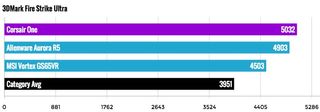
The One scored a 5,032 on the 3DMark Fire Strike Ultra test (which measures 4K performance), topping our 4,493 average and pulling slightly ahead of the GTX 1080-powered Vortex (4,503) and Aurora (4,902).
Numbers aside, what impressed me most about the One was how quiet it was. Whether I was running an intensive benchmark or playing long stretches of Mass Effect, I barely heard the system's fans.
Overall Performance
Packing an Intel Core i7-7700K processor and 16GB of RAM, the Corsair One was just as impressive while multitasking as it was at making PC games look great. I never encountered any noticeable slowdown on the machine, even as I bounced among multiple Twitch streams, emails and Google Docs while downloading a game and performing a system scan.

Corsair's PC netted a 17,755 on the Geekbench 4 performance test, topping our 16,341 average and beating the Geekbench 3 scores of the older Alienware Aurora (16,398; Core i7-6700K) and the Vortex (16,525; Core i7-6700K).
The One's 480GB SSD copied about 5GB of files in 21 seconds, for a solid transfer rate of 236.6 MBps. That tops our 295.54-MBps gaming PC average and the Aurora's 512GB SSD (198 MBps), but it trails the blistering 848 MBps we got from the Vortex's 512GB SSD.
Software
The Corsair One is pleasingly light on unwanted software, offering only a handful of utilities that PC gamers will likely get good use out of. I appreciated that the system came with a folder for installing popular game clients such as Steam, Origin and GOG, which let me get to my favorite titles faster.
The desktop's only other notable preinstalled program is Corsair Link, which provides a quick look at the temperature of the system's various components while also letting you tweak the LED lighting. There's also an included diagnostic tool that lets you run system scans, review your storage space and check for updates, all from a single convenient hub.
Configurations and Value
The Corsair One starts at $1,799, which includes an Intel Core i7-7700 processor, 16GB of RAM, a 240GB SSD with a 1TB hard drive, and Nvidia GTX 1070 graphics. Stepping up to the $2,199 Corsair One Pro will get you a Core i7-7700K processor, a 480GB SSD with a 2TB hard drive, and Nvidia's GTX 1080 GPU.
There's also a special $2,999 Pro model available on Corsair's web store that gets you a 960GB SSD for the extra cash. All configurations include a two-year parts-and-labor warranty.
Bottom Line
The Corsair One is powerful, small and quiet, making it a great gaming machine for people with limited desk space or anyone who wants a cool-looking PC for gaming on the TV. Its Intel Core i7 processor and GTX 1080 graphics provide big 4K and VR performance within a tiny frame, while its custom cooling system keeps the machine quiet even during the most intense firefights.
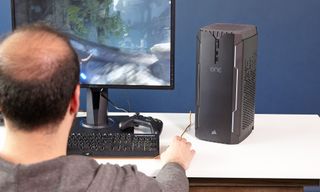
My only gripe with the Corsair One is its lack of customizability;its LED lights are slick but don't change color, and you can't swap components without getting your hands dirty with some tools. You can get an Alienware Aurora with similar specs for about the same price as the One, complete with a bigger but more upgrade-friendly chassis. The MSI Vortex is even smaller than the One but much more expensive, while the console-shaped, less-powerful MSI Trident is a better fit for entertainment centers.
Despite its stiff competition, the Corsair One's striking design and quiet, fast performance are hard to ignore. If you're in the market for a compact gaming PC that can run the latest games at their best, it should absolutely be on your radar.
Photo credit: Jeremy Lips/Tom's Guide
Sign up to get the BEST of Tom’s Guide direct to your inbox.
Upgrade your life with a daily dose of the biggest tech news, lifestyle hacks and our curated analysis. Be the first to know about cutting-edge gadgets and the hottest deals.
Mike Andronico is Senior Writer at CNNUnderscored. He was formerly Managing Editor at Tom's Guide, where he wrote extensively on gaming, as well as running the show on the news front. When not at work, you can usually catch him playing Street Fighter, devouring Twitch streams and trying to convince people that Hawkeye is the best Avenger.

